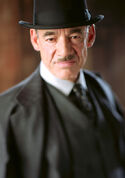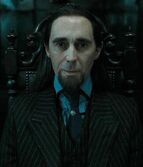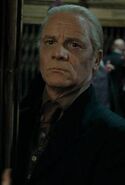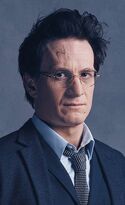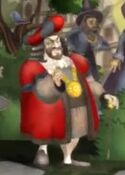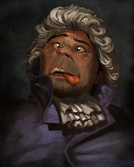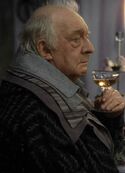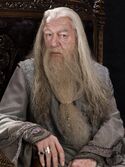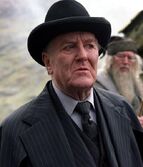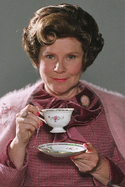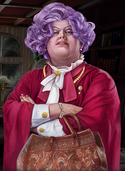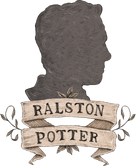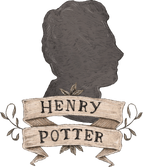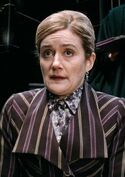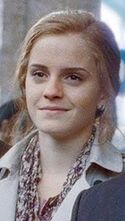
|
Warning!
At least some content in this article is derived from information featured in: Harry Potter: Hogwarts Mystery & Harry Potter: Magic Awakened. |

|
"Well, I think we should put it back in order for them, don't you?"
This entry needs to be cleaned up to conform to a higher standard of quality.
|
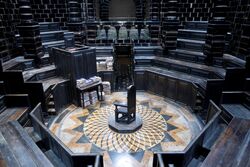
A wizarding courtroom
- "All new wizards must accept that, in entering our world, they abide by our laws."
- — Albus Dumbledore commenting on the laws of wizarding society[src]
Wizarding law, also known as magical law, was the system of rules that were created and enforced through social or governmental institutions to regulate behaviour. Magical law was a system that regulated and ensured that individuals or the wizarding community in general adhered to the will of the state.
Function[]
Once a witch or wizard entered the magical community, they must abide by the pre-existing laws that were already in place. These laws kept the peace and prevented anarchy, and it also gave citizens a higher authority to refer to. Consequently, elaborate and complex legal systems had been developed, aimed at maintaining order and disincentivising antisocial behaviours. There were many striking parallels between the Muggle and wizarding legal frameworks, but there were just as many differences.[1]
Law structure[]
- "The law’s on your side. Even underage wizards are allowed to use magic in life-threatening situations."
- — Remus Lupin commenting on magical law[src]
Punishments meted out were comparable in severity to the crimes to which they referred, and discretion played a part. Harry Potter correctly thought he was in for serious punishment for swelling Marjorie Dursley, yet was reassured by Cornelius Fudge that the powers-that-be "don't send people to Azkaban just for blowing up their aunts". This was of course only because Cornelius had an interest in Harry being free. By contrast, when Dolores Umbridge sought to neutralise the young wizard, she used her discretion to try and punish him most harshly and send him to prison.[1]
This application of discretion needed not be sneaky, or even serve the greater good. For example, when Igor Karkaroff was in the frame for his crimes as a Death Eater, he managed to reduce the severity of his sentence by volunteering the names of his associates. In Muggle legalese, this kind of legal activity was known as "plea-bargaining".[1]
Curiously, while a witch or wizard on trial at the Wizengamot could nominate a third party to represent them, there did not appear to be lawyers in the Muggle sense, just a panel who voted in a simple majority (as seen when Ludo Bagman was acquitted by the court by virtue of his status as a popular Quidditch hero). Perhaps the law wasn't seen as a particularly desirable career choice, as Hermione Granger acidly observed when asked by Rufus Scrimgeour if she sought a career in Magical Law.[1]
Crimes[]
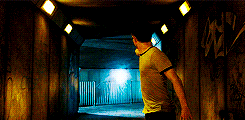
Harry Potter preforming underage magic in front of a muggle
Any young witch or wizard that tried to perform spells at home before the age of 17 would run afoul of the Decree for the Reasonable Restriction of Underage Sorcery (1875). The intention of this statute was presumably two-fold: to keep potentially dangerous or hazardous magic out of inexperienced hands prior to their proper education (policed by a Trace detection spell which automatically expired when the young witch or wizard turned 17), and also to prevent Muggles coming into contact with magic, as per the International Statute of Secrecy (1692).[1]
Although in the wizarding world, a lot of accidental underage magic tended to just result in a slapped wrist. Harry Potter received a mere letter for his early transgressions.[1]
In the field of animal law: Aberforth Dumbledore's brush with the law for "using inappropriate charms on a goat" needed little elaboration. It is interesting to note stringent controls on the trade of dragon eggs, the creating of Basilisks, "experimental breeding" in general and a statute banning the poaching of the Ramora fish, a magical native of the Indian Ocean.[1]
Taken most seriously, in both legal jurisdictions, were laws which pertained to crimes against the person. The most obvious examples were those laws which referred to murder or grievous bodily harm. A wizarding defendant could expect the harshest sentences for the darkest magic — the Unforgivable Curses.[1]
Punishment[]
- "They don't need walls and water to keep the prisoners in, not when they're trapped inside their own heads, incapable of a single cheerful thought. Most go mad within weeks."
- — Description of Azkaban prison[src]
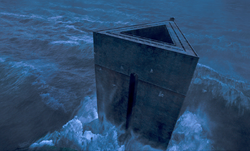
Azkaban
Minor infractions were settled with fines — such as when Arthur Weasley was penalised 50 Galleons for "bewitching a Muggle car". Custodial sentences were also doled out, but it probably went without saying that Muggle jails were not fit to restrain wizarding kind — as demonstrated by mischievous witch Lisette de Lapin, who broke out of a Parisian cell in 1422, much to the frustration of her would-be executioners. Azkaban was a highest-security prison (bringing even the doughty Rubeus Hagrid to tears), especially when patrolled by the soul-sucking Dementors.[1]
Another example of archaic punishment worth looking at happened in the United States of America. In 1926 New York, Porpentina Goldstein was suspended in a chair above the death potion, a method of execution hideously reminiscent of the medieval Muggle use of the cucking stool to dunk those accused of crimes in the water, sometimes until they drowned. Executions, in regards to people, did not seem to have happened in Great Britain.[1]
Miscarriages of justice[]
While the legal system performed a vital function maintaining order, the wizarding world seemed rather prone to mistakes and iffy outcomes. Sometimes this was a result of an unfairly weighted system, as when Buckbeak was sentenced to death for scratching a member of the politically influential Malfoy family. Also consider when Sirius Black was dispatched to Azkaban for Peter Pettigrew's crime, though he was later exonerated.[1]
It's worth taking heart from the idea that the law, while imperfect, was flexible. Even rule sticklers like Percy Weasley saw room for improvement in the system, and Hermione's tireless championing of house-elf rights reflected a noble tradition of fighting for justice.[1]
Corruption[]
- "Blatant corruption! The Ministry did not cut deals with petty criminals in my day, no sir, they did not!"
- — The portrait of Dexter Fortescue discussing the Ministry's actions[src]
While the law existed to carry out justice, sometimes it was outright undermined by officials who were corrupted by money, status and public opinion, far beyond a simple miscarriage. Ministers of Magic Cornelius Fudge and his successor Rufus Scrimgeour were more worried about the Ministry's reputation than actual security, thus they abused their authorities to manipulate the media, creating cover up stories, and knowingly arresting the wrong people to give the façade of progress. Other high-ranking officials were also known to have engaged in corrupt law-enforcement, such as Dolores Umbridge, who solicited bribes, bargained with petty criminals, and utilised outright illegal methods to achieve her goals such as ordering a Dementor attack or attempting to use the Cruciatus Curse for interrogation.[2]
When the Death Eaters took over the Ministry in 1998, corruption in the law system became outright evident, to the point of blatantly declaring evil as the new justice. Criminals were falsely cleared and given high-ranking positions in the Ministry, which included maintaining the law that they would be changing and inventing; innocent people were being imprisoned, pursued, or even killed under false pretences. Even children were being trained in illegal Dark Arts (which had been legalised and even encouraged to be used openly) and prejudiced hatred towards Muggles.[3]
Courtroom procedure[]
Wizengamot[]
- "Feeling rather sick he looked up at the people seated at the bench above. There were about fifty of them, all, as far as he could see, wearing plum-coloured robes with an elaborately worked silver W on the lefthand side of the chest and all staring down their noses at him, some with very austere expressions, others looks of frank curiosity."
- — Harry Potter viewing the Wizengamot in August 1995[src]
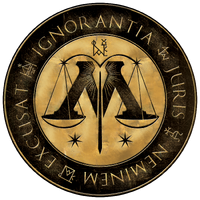
at=
The Wizengamot was the high court of wizarding law in Britain. The head of the Wizengamot was called the Chief Warlock, an old-fashioned title that denoted "particular skill or achievements" similar to a Muggle knighthood.[2]
Dumbledore held that post for years, but was temporarily removed from the post during the summer of 1995. He was reinstated in June of 1996. Those who presided over a hearing or a trial were called the interrogators. A Court Scribe took notes of the proceedings. Wizengamot members wore plum-coloured robes with an elaborate silver "W" on the left side. Other members of the Wizengamot included a dumpy wizard with a large black moustache and a frizzy-haired witch, both allied with Fudge against Dumbledore and Harry, and two elderly witches who were apparently friendly to Dumbledore.[2]
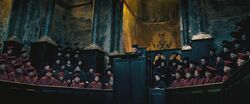
The Wizengamot in 1995
The full Wizengamot sat in judgement of Harry Potter on 12 August, 1995. The hearing took place in Courtroom Ten, which was located on Level 10 of the Ministry of Magic. This courtroom was identical to (and may very well have been the same one as) that which Harry saw in the Pensieve when he "attended" several proceedings from Dumbledore's memory. The walls of Courtroom Ten were dark stone, dimly lit by torches.[2]
In the centre of the room was a chair with magical chains on it where the accused sat. The court members, of which there were about fifty, sat above overlooking the chair in the judge's balcony. When Harry was being accused, Amelia Bones herself presided. She sat to the left of Cornelius Fudge. Umbridge sat to Fudge's right.[2]
According to the Wizengamot Charter of Rights, the accused was allowed to call witnesses in their defence and to be represented by another person. Harry was represented by Dumbledore, much to his surprise, and Mrs Figg was called as a witness for the defence.[2]
Council of Magical Law[]
- "Ludo Bagman, you have been brought here in front of the Council of Magical Law to answer charges relating to the activities of the Death Eaters."
- — Bagman's trail before the council[src]
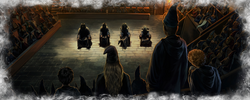
The high wizard court of law was held in a dungeon. In court, the accused was magically bound to a chair in the centre of the room. A jury sat on the right of the prosecutor who stated the case against the accused and eventually asked for a verdict.
The courtrooms were located on the tenth level of the Ministry of Magic. During Voldemort's years, prisoners were escorted and guarded by groups of Dementors.
The members of the Wizengamot, of which there were about fifty, wore plum-covered robes with elaborate silver initials on them (the letter 'W').
Harry Potter, looking in the Pensieve, saw Council of Magical Law trials taking place for Igor Karkaroff and Ludo Bagman, as well the sentencing of the Death Eaters (the Lestranges and Barty Crouch Jnr) who had used the Cruciatus Curse on Alice and Frank Longbottom.
Trials[]
Trials appeared to be brief and concise. The accused might present witnesses to be questioned by the Wizengamot. A third-party with legal knowledge might speak on behalf of a defendant, fulfilling a similar role to that of a modern barrister. However, no wizarding lawyers seemed to exist, and the practice of having a spokesperson on behalf of a defendant appeared to be rare.
During the First Wizarding War, then-Head of the Department of Magical Law Enforcement Bartemius Crouch Senior forwent trials for many captured suspects, sending them straight to prison. While this prevented many criminals from manipulating the court to escape justice, it also led to wrongful imprisonments due to lack of chance for such people to speak their sides of the stories.
Law enforcement[]
- "Level two, Department of Magical Law Enforcement, including the Improper Use of Magic Office, Auror Headquarters, and Wizengamot Administration Services."
- — Description of the department[src]

The Department of Magical Law Enforcement was in the British Ministry of Magic, which was the wizarding equivalent of both the Muggle police force and the judiciary. It was roughly the equivalent to the Home Office of Muggle Britain and all other departments were answerable to this one, with the exception of the Department of Mysteries.[4] It was also the largest of the departments in the Ministry of Magic.
Minister for Magic Ulick Gamp's greatest legacy was having founded the Department of Magical Law Enforcement. The Wizengamot and Council of Magical Law were subdivisions of this department.
There were several different subdivisions located in this department, such as the Auror Office, Improper Use of Magic Office, Magical Law Enforcement Patrol and many others.
MACUSA also had its own version of the Department of Magical Law Enforcement.
Existing laws[]
- "Professor Dumbledore, these boys have flouted the Decree for the Restriction of Underage Wizardry, caused serious damage to an old and valuable tree — surely acts of this nature —"
- — Harry Potter and Ron Weasley break wizarding law in 1992[src]
There were numerous pre-existing law in the wizarding world, ranging from relatively important to the up most importance.
Ban on Experimental Breeding[]
The Ban on Experimental Breeding was a rule that forbade the creation of new, dangerous magical creatures in Britain. It was designed by Newt Scamander, who thought it the greatest achievement of his career, and passed in 1965.[4] The creation of new breeds of magical creatures was now subject to close control by the Department for the Regulation and Control of Magical Creatures.[5]
Rubeus Hagrid probably acted in defiance of the Ban on Experimental Breeding when he cross-bred Fire Crab with Manticores to create Blast-Ended Skrewts.[5]
On the day of Harry Potter's hearing in front of the Wizengamot, he and Arthur Weasley met Bob, a Ministry employee who carried a cardboard box containing a fire-breathing chicken. Bob was certain that the chicken constituted a serious breach of the Ban on Experimental Breeding.[2]
Code of Wand Use[]
The Code of Wand Use was a law in the wizarding world that regulated the use of wands. Clause three of the Code of Wand Use stated that "no non-human creature is permitted to carry or use a wand". Its precursor was presumably the Wand Ban of 1631, which also forbade the possession of wands by non-human magical beings.[6]
Amos Diggory accused Winky of breaking clause three of the Code of Wand Use when he found her holding the wand Barty Crouch Jnr used to conjure the Dark Mark at the Quidditch World Cup of 1994.[5]
Decree for Justifiable Confiscation[]
The Decree for Justifiable Confiscation was a wizarding law that allowed the Ministry of Magic to confiscate the contents of any will in case they suspected of it being an illegal item. The Ministry could keep the possessions for investigation for 31 days.
Rufus Scrimgeour used that Decree to investigate some of the possessions that Dumbledore left to Harry Potter, Ron Weasley, and Hermione Granger.[3]
Decree for the Reasonable Restriction of Underage Sorcery[]
The Decree for the Reasonable Restriction of Underage Sorcery was written in 1875 by the Ministry of Magic.[7] This law forbade the use of underage magic outside of school, and was enforced by the Improper Use of Magic Office. Warnings were given for violation of paragraph C, which was to knowingly, deliberately and in full awareness of illegality do magic in a Muggle-inhabited area and in the presence of a Muggle.
More than one offence might cause a student to be expelled from Hogwarts and their wand broken. Clause 7 stated magic might be used before Muggles in exceptional circumstances, which included situations that posed a threat to the life of the wizard or witch themself, or witches, wizards, or Muggles present.[2]
Young wizards were also exempt from this rule because they had little control over what magic came out of them, and they did not own a wand. Their magic was rarely dangerous to others, and usually accidental, such as when Harry flew onto the school roof while being chased by Dudley's gang, or made his hair grow after Petunia cut it. Even when Harry made the glass in the Reptile House disappear and released the boa constrictor, it was not counted against him.[8]
Guidelines for the Treatment of Non-Wizard Part-Humans[]
The Guidelines for the Treatment of Non-Wizard Part-Humans were an official Ministry of Magic document that provided rules for the treatment of part-human magical creatures such as vampires by wizards. Paragraph twelve contained regulations for vampire hunting. It is unknown to which other part-human creatures the guidelines applied; possible candidates included centaurs, merpeople, hags and Veela. The wand ban also affected goblins,[3] so it can be assumed that house-elves and goblins were considered "non-human" instead of "part-human".
In a Daily Prophet article published a week before the final match of the Quidditch World Cup of 1994, Rita Skeeter complained that the Ministry employees wasted time arguing over cauldron thickness when they should be "stamping out vampires". Percy Weasley angrily rejected the criticism and pointed out that paragraph twelve of the Guidelines for the Treatment of Non-Wizard Part-Humans clearly forbade such a policy.[5]
International Ban on Duelling[]
The International Ban on Duelling was a ban that, seen as it was international, probably was passed by the International Confederation of Wizards after 1994. During the winter of 1994, the British Ministry of Magic seemed to have accepted it and attempted to convince other wizarding governments to do the same, as they were trying to convince other countries to agree to this ban.
International Statute of Wizarding Secrecy[]

The International Statute of Wizarding Secrecy was a wizarding law which was instituted in 1689 and put into effect in 1692 in order to hide the existence of witches and wizards from the Muggles who persecuted them. This law was probably a direct outcome of the Salem Witch Trials of 1692-93 in Massachusetts Colony of North America. 1692 was also the same year that the Magical Congress of the United States (MACUSA) was founded with the main goal of hunting down the Scourers who turned over witches and wizards to the Puritan judges.[1]
In 1692, the International Confederation of Wizards held a summit. It was established that each Ministry of Magic would be responsible for magical sports in their own country. This led to the formation of the Department of Magical Games and Sports in Britain.[9] Twenty-seven species of magical beasts, beings, and spirits were to be hidden from Muggle knowledge.[4]
In 1750, Clause 73 was added to the Statute, which stated that each Ministry would be responsible for the concealment of magical creatures within its territory or face sanction from the International Confederation of Wizards.[4]
The Statute also included guidelines for dress, which stated what wizards should wear in order to avoid discovery.[1]
Muggle Protection Act[]
The Muggle Protection Act was the reason why the Ministry conducted raids; forcing Lucius Malfoy to go to Borgin and Burkes and sell some family items, poisons among them. He thought Arthur might be behind it, whilst Arthur was somewhat pleased to hear that Lucius was apprehensive.[7]
Rappaport's Law[]
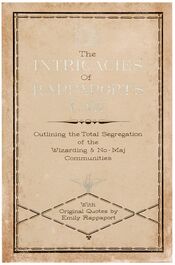
Rappaport's Law was instituted by Emily Rappaport, the 15th President of MACUSA, in 1790. The law completely segregated the No-Maj and magical communities in the United States following one of the most serious breaches of the International Statute of Secrecy of all time.[1]
Rappaport's Law banned marriage and even friendship between Wizards and No-Maj. Interaction was only allowed for everyday activities.[1]
Due to the law, students from Ilvermorny School were not allowed wands before they entered the school, nor to take them home during vacations.[1]
By the 1920s, MACUSA had several special offices responsible for enforcing Rappaport's Law. Among these were a sub-division focusing on No-Maj fraternisation and an office that issued and verified wand permits for every witch or wizard in the United States.[1]
Rappaport's Law was repealed in 1965.[1]
Registry of Proscribed Charmable Objects[]
The Registry of Proscribed Charmable Objects presumably listed the artefacts that could be used in a magical way by the wizarding world.[5] The broomstick, for example, was presumably on the list.
Werewolf Code of Conduct[]
An ultimately unsuccessful rule framework developed by the Ministry of Magic in 1637 for the control of Werewolves.[1]
The Werewolf Code of Conduct of 1637 was meant to give werewolves a framework for co-existing safely and legally within the wizarding world. Werewolves were required to sign a copy of the Code and promise to refrain from attacking and biting non-werewolves. They were also supposed to lock themselves away during their wolf transformation periods.[1]
As no undeclared werewolf wanted to go into the Ministry and admit to being one, none ever signed up to the Code.[1]
Wizengamot Charter of Rights[]
The accused had the right to present witnesses for their case.[2]
All wizards and witches of school age or older were kept track of on a register of their places of residence, so that the Wizengamot knew that as of his disciplinary hearing, he was the only one of either in Little Whinging. However, they did not keep track of Squibs, and may not have kept track of Muggle-born wizards and witches too young to enter Hogwarts.[2]
All Animagi must be registered with the Ministry of Magic.[10][5]
There was legislation about what could be conjured and what could not.
The use of Veritaserum was closely controlled by Ministry guidelines.[5]
One must have a licence to Apparate from the Department of Magical Transportation.[5]
One must clip the distinctive forked tail of a crup to hide it from Muggle notice.[4]
Law practitioners[]
Heads of the Department of Magical Law Enforcement[]
Wizengamot members[]
- Griselda Marchbanks (resigned)
- Tiberius Ogden (resigned)
- Two elderly witches
- Dumpy, heavily-moustached wizard
- Frizzy-haired witch
Others[]
Law in literature[]
There had been numerous books written under the subject of the law, and it can be safely assumed that these books were available to Magical Law Enforcement personnel. These books might also play an important part in law proceedings and might prove useful for those who pursued a career in magical law. Some books included:
- Ancient Law
- International Laws of Apparition and Travel
- Law & Literature
- Laws of Conduct When Dealing with Muggles
- Magical Misdemeanours and the Modern Law
- Muggle 'Law & Order' - Complete Guide
- Spell Casting in the Age of Rappaport's Law
- The Intricacies of Rappaport's Law
Appearances[]
- Harry Potter and the Philosopher's Stone (First appearance)
- Harry Potter and the Philosopher's Stone (video game) (Mentioned on a Famous Wizard Card)
- Harry Potter and the Chamber of Secrets
- Harry Potter and the Chamber of Secrets (film)
- Harry Potter and the Chamber of Secrets (video game) (Mentioned on a Famous Wizard Card)
- Harry Potter and the Prisoner of Azkaban
- Harry Potter and the Prisoner of Azkaban (film)
- Harry Potter and the Prisoner of Azkaban (video game)
- Harry Potter and the Goblet of Fire
- Harry Potter and the Goblet of Fire (film)
- Harry Potter and the Order of the Phoenix
- Harry Potter and the Order of the Phoenix (film)
- Harry Potter and the Order of the Phoenix (video game)
- Harry Potter and the Half-Blood Prince
- Harry Potter and the Deathly Hallows
- Harry Potter and the Deathly Hallows: Part 1
- Harry Potter and the Deathly Hallows: Part 1 (video game)
- Harry Potter and the Cursed Child
- Harry Potter and the Cursed Child (play)
- Fantastic Beasts and Where to Find Them: The Original Screenplay
- Fantastic Beasts and Where to Find Them (film)
- Fantastic Beasts: The Crimes of Grindelwald - The Original Screenplay
- Fantastic Beasts: The Crimes of Grindelwald
- Fantastic Beasts: The Secrets of Dumbledore - The Complete Screenplay
- Fantastic Beasts: The Secrets of Dumbledore
- Fantastic Beasts and Where to Find Them
- Quidditch Through the Ages
- The Tales of Beedle the Bard (Mentioned only)
- Pottermore
- Wizarding World
- LEGO Harry Potter: Years 1-4
- LEGO Harry Potter: Years 5-7
- LEGO Dimensions
- Wonderbook: Book of Spells
- Fantastic Beasts: Cases from the Wizarding World
- Harry Potter: Hogwarts Mystery (Mentioned only)
- Harry Potter: Wizards Unite
- Harry Potter: Magic Awakened
Notes and references[]
- ↑ 1.00 1.01 1.02 1.03 1.04 1.05 1.06 1.07 1.08 1.09 1.10 1.11 1.12 1.13 1.14 1.15 1.16 1.17 1.18 1.19 1.20 1.21 Pottermore
- ↑ 2.0 2.1 2.2 2.3 2.4 2.5 2.6 2.7 2.8 2.9 Harry Potter and the Order of the Phoenix
- ↑ 3.0 3.1 3.2 Harry Potter and the Deathly Hallows
- ↑ 4.0 4.1 4.2 4.3 4.4 Fantastic Beasts and Where to Find Them
- ↑ 5.0 5.1 5.2 5.3 5.4 5.5 5.6 5.7 Harry Potter and the Goblet of Fire
- ↑ W.O.M.B.A.T.
- ↑ 7.0 7.1 Harry Potter and the Chamber of Secrets
- ↑ Harry Potter and the Philosopher's Stone
- ↑ Quidditch Through the Ages
- ↑ Harry Potter and the Prisoner of Azkaban


